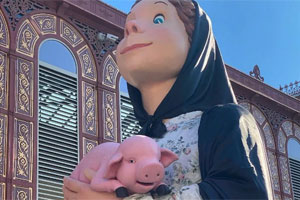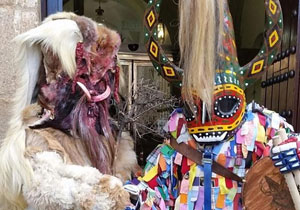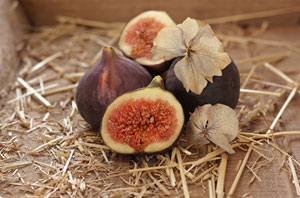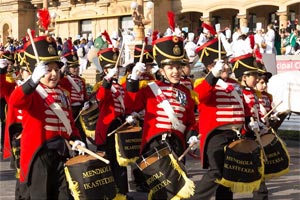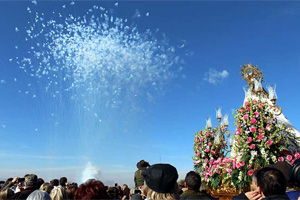The pilgrimage of the Virgin of the Cabeza
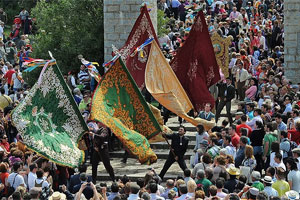
How the pilgrimage of the Virgen de la Cabeza is celebrated
"The Pilgrimage of the Virgen de la Cabeza" is a traditional pilgrimage that takes place in Andújar, Andalusia, in honor of the Virgen de la Cabeza, the patron saint of Andújar, captain of the civil guard and also the patron saint of the diocese of Jaén. It is possibly the oldest pilgrimage in Spain.
Every year, on the last weekend of April, thousands of pilgrims from all over Spain and other parts of the world head to the Shrine of the Virgen de la Cabeza, located in the Sierra de Andújar Natural Park. For three days, events surrounding this festivity take place, culminating on Sunday with the pilgrimage.
The celebration of the Virgen de la Cabeza begins with the traditional proclamation a week before the pilgrimage and extends over the following days with a wide variety of religious and festive events in honor of the Virgen de la Cabeza, known as "La Morenita" due to her dark complexion.
During the following days, the streets of Andújar are prepared to receive thousands of pilgrims coming from different parts of Spain. The preparations culminate on Thursday with the floral offering to the Virgin, whose image is a replica of the one found in the Shrine.
On Friday, the official reception takes place by the Main Brotherhood of Andújar to the subsidiary Brotherhoods that attend the Pilgrimage to pay homage to "La Morenita".
Saturday is the day of the great pilgrimage to the Shrine, where pilgrims dressed in typical costumes, on foot or on horseback, travel the path that leads them to the top of the mountain. The culmination of the Pilgrimage takes place on Sunday with the procession of the Virgen de la Cabeza.
The importance of this Marian devotion and its influence on the Spanish population is reflected in the many literary references that over the centuries have been made to the Virgen de la Cabeza and her Pilgrimage. Writers such as Miguel de Cervantes, Lope de Vega, Calderón de la Barca, and others have mentioned the Pilgrimage in their literary works.
The Pilgrimage of the Virgen de la Cabeza is one of the most important festivities in Andalusia and has been declared a National Tourist Interest since 1965. In addition to its religious value, the pilgrimage is also an opportunity to enjoy Andalusian gastronomy and culture.
Origin and History
The devotion to the Virgin of the Cabeza has a long history dating back to the 13th century. According to popular legend, a shepherd named Juan Alonso de Rivas was tending to his cattle on the night of August 11-12, 1227, when he saw a series of strange lights on the top of the hill. Upon hearing the sound of a bell, he decided to climb to the top of the mountain, where he found an image of the Virgin of the Cabeza. It is said that the Virgin healed his paralyzed arm and asked him to build a chapel in her honor in that place. The inhabitants of the area then built a small chapel where the image was found and began to worship it.
In the 16th century, the chapel of the Virgin of the Cabeza was rebuilt and expanded by the bishop of Jaén, who also declared the image as the patron saint of the Sierra de Andújar. Since then, devotion to the Virgin of the Cabeza has spread throughout Andalusia and other parts of Spain.
The tradition of the Romería of the Virgin of the Cabeza began in the 17th century, when the inhabitants of Andújar began to make pilgrimages to the chapel to pay homage to the Virgin. Over time, the pilgrimage became a popular festival that attracted thousands of people from all over Spain.
During the Spanish Civil War, the Sanctuary of the Virgin of the Cabeza was destroyed after a long siege, but was rebuilt in 1942. Since then, the devotion and celebration of the Romería of the Virgin of the Cabeza have continued to this day, becoming one of the most important religious and cultural festivals in Andalusia.
Trivia
Some curiosities about the Romería of the Virgin of the Cabeza:
- The name of the Virgin of the Cabeza is due to the fact that the image was found on the top of a mountain shaped like a head, the Cerro Cabezo.
- The pilgrimage of the Romería of the Virgin of the Cabeza is the second largest in Spain, after the pilgrimage of El Rocío, in Ayamonte.
- During the Romería, pilgrims wear typical Andalusian costumes, with wide-brimmed hats and ruffled skirts for women, and short jackets and wide-brimmed hats for men.
- The Romería route is about 22 kilometers long and is done on foot or on horseback, with the final stretch being a very steep climb towards the chapel.
- During the Romería, numerous booths can be found where typical Andalusian food and drinks are served, such as the famous Iberian ham and fine wine.
- The Virgin of the Cabeza is also the patron saint of other places in Spain, such as Villanueva de los Infantes, in the province of Ciudad Real.
- In 2020, due to the COVID-19 pandemic, the Romería of the Virgin of the Cabeza was canceled for the first time in its history.
What to see in Andújar
Andújar is a Spanish city located in the province of Jaén. Here are some interesting places you can visit if you travel to Andújar:
- Sanctuary of the Virgin of the Head: This sanctuary is one of the most emblematic places in the area, as it is where the image of the Virgin of the Head, patron saint of the city and the Sierra de Andújar, is located.
- Castle of Andújar: This is a fortress built in the 9th century by the Muslims. Currently, only some parts of the wall and a tower are preserved.
- Plaza de España: This is one of the most important squares in the city, surrounded by historic buildings and with a central fountain that makes it a meeting place for the inhabitants of Andújar.
- Church of San Miguel: This is a church built in the 17th century, in Baroque style, which has an impressive façade and a bell tower that is 44 meters high.
- Archaeological Museum of Andújar: This museum houses an interesting collection of archaeological objects from the Iberian and Roman periods found in the area, as well as some pieces of sacred art.
- Sierra de Andújar Natural Park: This natural park is an ideal place for nature lovers, as it has a great variety of native flora and fauna, such as the Iberian lynx, the imperial eagle and the griffon vulture.
These are just some of the places you can visit in Andújar and its surroundings, a city with a rich historical and cultural heritage.
Recommended Crafts and Shopping
If you are interested in crafts and shopping, in Andújar you can find a variety of local and regional products that are highly recommended. Here are some options:
- Andújar Ceramics: Ceramics are one of the main crafts of the area, with a long tradition. You can find a great variety of products, from plates and vases to decorative objects and souvenirs.
- Blankets and Textiles: The Andújar area is known for its woolen blankets, hand-woven. You can also find other textiles, such as cushions and tapestries, which are very typical of the area.
- Olive Oil: Jaén is the main producer province of olive oil in Spain, and Andújar is no exception. You can find a great variety of local oils of excellent quality, with different characteristics and flavors.
- Sweets and Pastries: Andújar has a rich tradition in pastry, with specialties such as pestiños, wine rings, alfajores, and hornazos. These products are ideal to take as souvenirs or to enjoy during your visit.
- Leather Crafts: Leather is another typical product of the area, with a long tradition in the production of items such as bags, belts, wallets, and other accessories.
- Wine and Liquors: The Andújar area is also known for its wines and liquors, such as the famous fino wine and sweet anise. You can find a great variety of local brands and products to taste and take with you.
These are just some of the options for crafts and local products that you can find in Andújar. Do not hesitate to explore the city and discover all the options it has to offer.
What to eat in Andújar
Andújar's cuisine is very diverse and rich, with traditional dishes made from high-quality local ingredients. Here are some of the dishes you should try if you visit the city:
- Game meat stew: This dish is one of the most typical in the area, made with game meat and vegetables, slow-cooked in a clay pot.
- Migas with "tropezones": Migas are a very popular dish in Andalusia, and in Andújar they are served with chunks of bacon, chorizo, and blood sausage, accompanied by fried peppers.
- Ajoatao: It is a traditional garlic soup, made with bread, garlic, paprika, and olive oil. It is served hot and is ideal for cold winter days.
- Pickled partridge: Partridge is a very common bird in the area and is usually pickled with a mixture of vinegar, olive oil, bay leaves, cloves, and pepper. It is served cold and is a delight for the palate.
- Flamenco-style eggs: This dish is made with eggs, tomato, onion, bell pepper, and serrano ham. It is baked in the oven and served hot.
- Typical sweets: Andújar has a great variety of traditional sweets, such as "pestiños", "roscos de vino", "alfajores", and "hornazos", which are perfect to accompany coffee or tea.
You cannot miss trying these typical dishes of Andújar's cuisine. In addition, the city has a wide gastronomic offer, with high-quality restaurants where you can taste a great variety of local and regional dishes.

